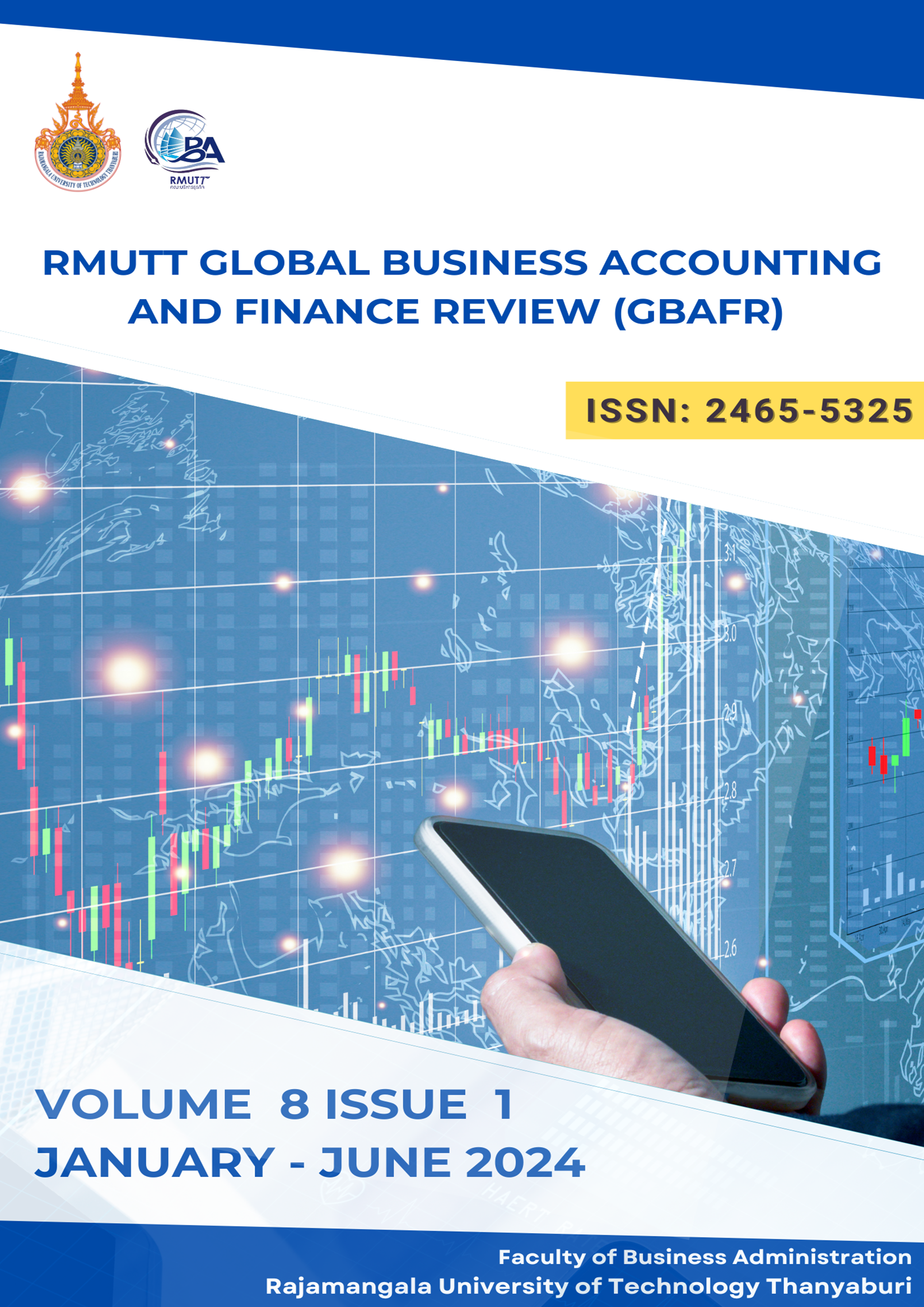INTERNATIONAL MARKET SELECTION FOR FROZEN SHRIMP EXPORTS FROM THAILAND: AN INTEGRATION OF CAGE DISTANCE FRAMEWORK AND DATA ENVELOPMENT ANALYSIS
DOI:
https://doi.org/10.60101/gbafr.2024.271583Keywords:
International market selection, Frozen shrimp exports, CAGE Distance framework, Data envelopment analysis, DEAAbstract
Purpose – This research aims to assess and rank the efficiency of countries where Thailand exported frozen shrimp to, and to provide actionable insights for policymakers and stakeholders in the frozen shrimp export industry based on the efficiency scores.
Methodology – This study employed the integration of the CAGE Distance Framework and Data Envelopment Analysis (DEA) to investigate the dynamics of international market selection for frozen shrimp exports from Thailand. The study evaluated and ranked the effectiveness of 20 nations that were chosen based on 2022 export values exceeding 1,000,000 US Dollars. The DEA BCC model, utilizing linear programming techniques, categorized these countries as Decision Making Units (DMUs), assessing their efficiency to determine how efficiently a DMU produced outputs given a set level of inputs.
Results – Results from the DEA analysis highlighted efficiency leaders with an efficiency score of 1, such as China, the United States, Japan, Taiwan, Hong Kong SAR, Australia, Myanmar, Vietnam, Singapore, Cambodia, and Laos. Additionally, it identified intermediate performers with room for improvement and countries with opportunities for optimization.
Implications – This integrated methodology served as a valuable guide for future students and professionals navigating the complexities of the global frozen shrimp trade.
Originality/Value – The integration of the CAGE framework with DEA offered a unique approach that had not been explored in previous applications. It established a pioneering approach for policymakers, practitioners, and entrepreneurs.
References
Alexander, N., Rhodes, M., & Myers, H. (2007). International market selection: measuring actions instead of intentions. Journal of Services Marketing, 21(6), 424-434.
Anderson, J., & Neary, J. (2007). Welfare versus market access: the implications of tariff structure for tariff reform. Journal of International Economics, 71(1), 187-205.
Apergis, N., & Cooray, A. (2015). Economic freedom and income inequality: evidence from a panel of global economies— a linear and a non‐linear long‐run analysis. Manchester School, 85(1), 88-105.
Az-zakiyah, N. (2023). Impact of gravity model and domestic market obligation (DMO) on coal Indonesian export. Optimum Jurnal Ekonomi Dan Pembangunan, 13(1), 38-48.
Babin, B. J., & Harris, E. J. (2016). Consumer culture. In Consumer Behavior (pp. 180-201), MA, United States: Cengage Learning.
Banker, R. D., Charnes, A., & Cooper, W. W. (1984). Some models for estimating technical and scale inefficiencies in data envelopment analysis. Management Science, 30(9), 1078-1092.
Beugelsdijk, S., Kostova, T., Kunst, V., Spadafora, E., & Essen, M. (2017). Cultural distance and firm internationalization: a meta-analytical review and theoretical implications. Journal of Management, 44(1), 89-130.
Boussofiane, A., Dyson, R.G., & Thanassoulis, E. (1991) Applied Data Envelopment Analysis. European Journal of Operational Research, 52, 1-15.
Burnie, D. (2019). Democracy, dictatorship, and economic freedom signals in stock market. International Journal of Finance & Economics, 26(1), 375-390.
Calabrese, A., Capece, G., Costa, R., & Pillo, F. (2015). Global market and commercials: understanding cultural diversities. Knowledge and Process Management, 22(3), 167-179.
Cano, I., Best, D., Edwards, M., & Lehman, J. (2017). Recovery capital pathways: Modelling the components of recovery wellbeing. Drug and Alcohol Dependence, 181, 11-19. https://doi.org/10.1016/j.drugalcdep.2017.09.002
Chen, C., Chang, C., & McCarl, B. (2011). The equivalence of tariffs and quotas under a tariff-rate quota system: a case study of rice. Canadian Journal of Agricultural Economics/Revue Canadienne D Agroeconomie, 59(4), 573-587.
Chen, H. (2008). Stock selection using data envelopment analysis. Industrial Management & Data Systems, 108(9), 1255-1268.
Chen, Y., & Chai, L. (2022). How far are we from the planetary health diet? a threshold regression analysis of global diets. Foods, 11(7), 986.
Cooper, W. W., Seiford, L. M. & Tone, K. (2007). Data Envelopment Analysis: A Comprehensive Text with Models, Applications, References and DEA-Solver Software (2nd Edition). Springer.
Countries of the World. (n.d.). World Time Zones. https://www.countries-ofthe-world.com/world-time-zones.html
Debaere, P. (2010). Small fish–big issues: the effect of trade policy on the global shrimp market. World Trade Review, 9(2), 353-374.
Doanh, N., Truong, L., & Heo, Y. (2020). Impact of institutional and cultural distances on ASEAN's trade efficiency. Journal of Economic Studies, 49(1), 77-94.
Douglas, S., & Craig, C. (2011). The role of context in assessing international marketing opportunities. International Marketing Review, 28(2), 150-162.
Dow, D. (2000). A note on psychological distance and export market selection. Journal of International Marketing, 8(1), 51-64.
Elia, S., Larsen, M., & Piscitello, L. (2019). Entry mode deviation: a behavioral approach to internalization theory. Journal of International Business Studies, 50(8), 1359-1371.
Elkefi, S., & Layeb, S. B. (2022). Application of Data Envelopment Analysis for pharmaceutical export decision-making during the COVID-19 pandemic. In 2022 5th International Conference on Advanced Systems and Emergent Technologies (IC_ASET) (pp. 167-171). Hammamet, Tunisia.
Evans, J., Mavondo, F., & Bridson, K. (2008). Psychic distance: antecedents, retail strategy implications, and performance outcomes. Journal of International Marketing, 16(2), 32-63.
Ferreira, M., & Falcão, M. (2019). The impact of CAGE institutional distances and motivations for internationalization on the Brazilian foreign direct investment outflows. Brazilian Business Review, 16(2), 154-173.
Furrer, O., Liu, B., & Sudharshan, D. (2000). The relationships between culture and service quality perceptions. Journal of Service Research, 2(4), 355-371.
Ghemawat, P. (2001). Distance Still Matters. The Hard Reality of Global Expansion. Harvard Business Review, 79(8),137-147.
Golany, B., & Roll, Y. (1989) An Application Procedure for DEA. Omega, 17(3), 237-250.
Gollnhofer, J., & Turkina, E. (2015). Cultural distance and entry modes: implications for global expansion strategy. Cross Cultural Management an International Journal, 22(1), 21-41. https://doi.org/10.1108/ccm-07-2013-0114
Google Maps. (n.d.). Distance between countries. https://www.google.co.th/maps/@18.3170581,99.3986862,17z?hl=th
Guesmi, K., & Nguyen, D. (2011). How strong is the global integration of emerging market regions? an empirical assessment. Economic Modelling, 28(6), 2517-2527.
Ha, N., Binh, Q., & Dang, P. (2020). Cultural distance and entry modes in emerging markets: empirical evidence in Vietnam. Journal of Risk and Financial Management, 13(1), 14.
Hasani-Nasab, M., & Shirazian, Z. (2019). The effect of marketing mix on export development with regard to the mediating role of market competition. Ecorfan Journal Mexico, 34-45.
Hassan, S., & Othman, Z. (2015). The effect of economic resilience on private investment in selected Malaysian economic sectors. Mediterranean Journal of Social Sciences, 6(6), 374-380. https://doi.org/10.5901/mjss.2015.v6n6p374
He, C., Quagrainie, K., & Wang, H. (2013). Determinants of shrimp importation into the USA: an application of an augmented gravity model. Journal of Chinese Economic and Business Studies, 11(3), 219-228.
Hearn, B., Phylaktis, K., & Piesse, J. (2017). Expropriation risk by block holders, institutional quality and expected stock returns. Journal of Corporate Finance, 45, 122-149.
Hitt, M., Ahlstrom, D., Dacin, M., Levitas, E., & Svobodina, L. (2004). The institutional effects on strategic alliance partner selection in transition economies: china vs. Russia. Organization Science, 15(2), 173-185.
Hofstede Insights. (n.d.). Country Comparison Tool. https://www.hofstede-insights.com/country-comparison-tool
Hossain, M., Kibria, M., & Islam, M. (2018). Does globalization affect the economic growth of Bangladesh? - an econometric analysis. Asian Economic and Financial Review, 8(12), 1384-1393.
Hranaiova, J., & Gorter, H. (2006). State trading and tariff rate quotas: the case of Korea’s rice imports. Review of Development Economics, 10(4), 632-651.
Huang, C., Chiou, C., Wu, T., & Yang, S. (2014). An integrated DEA-MODM methodology for portfolio optimization. Operational Research, 15(1), 115-136.
Huang, Y., & Rundle-Thiele, S. (2014). The moderating effect of cultural congruence on the internal marketing practice and employee satisfaction relationship: an empirical examination of Australian and Taiwanese born tourism employees. Tourism Management, 42, 196-206.
Hwang, H., Kao, K., & Peng, C. (2011). Tariff and quota equivalence in vertically related markets. Review of Development Economics, 15(1), 19-32.
International Monetary Fund. (2023). World Economic Outlook: Gross Domestic Product per Capita. https://www.imf.org/external/datamapper/NGDPDPC@WEO/OEMDC/ADVEC/WEOWORLD
International Monetary Fund. (2023). World Economic Outlook: Inflation Rate (Consumer Prices). https://www.imf.org/external/datamapper/PCPIPCH@WEO/ECU
Iqbal, J., Rehman, A., Nabi, I., Razzaq, A., Saqib, R., Bakhsh, A., … & Luqman, M. (2020). Performance and macroeconomic determinants of basmati rice exports from Pakistan. Sarhad Journal of Agriculture, 36(2), 617-624. http://dx.doi.org/10.17582/journal.sja/2020/36.2.617.624
Kapchanga, D., Owili, P., & Onyuma, S. (2018). Does public debt moderate the effect of inflation rate on securities market returns in Kenya?. International Journal of Scientific Research and Management, 6(12), 824-838.
Kawahara, S. (2013). Trade, environment and market access: policy reforms in a small open economy. Environment and Development Economics, 19(2), 173-181.
Kedžo, M., & Škrinjarić, T. (2015). Equity portfolio optimization: a DEA based methodology applied to the Zagreb stock exchange. Croatian Operational Research Review, 6(2), 405-417.
Khaliqi, M., Rifin, A., & Adhi, A. (2018). Trade effect of sanitary and phytosanitary (SPS) and technical barriers to trade (TBT) on Indonesia's shrimp export. Indonesian Journal of Agricultural Research, 1(2), 134-141.
Lam, D., Lee, A., & Mizerski, R. (2009). The effects of cultural values in word-of-mouth communication. Journal of International Marketing, 17(3), 55-70.
Lan, N. (2013). Social and ecological challenges of market-oriented shrimp farming in Vietnam. Springerplus, 2(1), 675.
Laurinavičius, A., & Laurinavičius, A. (2021). Macroeconomic variables influencing housing prices in Vilnius. International Journal of Strategic Property Management, 26(1), 24-34.
Lii, Y., Wu, K., & Ding, M. (2011). Doing good does good? sustainable marketing of CSR and consumer evaluations. Corporate Social Responsibility and Environmental Management, 20(1), 15-28.
Liu, J., Fang, M., Jin, F., Cheng-song, W., & Chen, H. (2020). Multi-attribute decision making based on stochastic dea cross-efficiency with ordinal variable and its application to evaluation of banks’ sustainable development. Sustainability, 12(6), 2375.
Long, N., Gam, N., Van, V., & Ngoc, B. (2023). The role of cultural and institutional distances in international trade. Emerging Science Journal, 7(2), 507-519.
Lv, J., Xiong, Y., & Zheng, Y. (2021). Determinants of outward foreign direct investment entry mode choice: evidence from Chinese-listed companies. Chinese Management Studies, 16(1), 231-243.
Maciel, J., Radomska, J., & Silva, S. (2020). Challenges of international market selection – the perspective of Mexican and Brazilian multilatinas. Contemporary organisation and management. Challenges and trends (pp.77-93).
Mahyideen, J., aziz, N., Yaakob, H., Rusli, N., & Mohamad, W. (2021). Efficiency analysis of Malaysian general insurance companies using data envelopment and super-efficiency approach. International Journal of Academic Research in Progressive Education and Development, 10(3), 789-800.
Malhotra, S., Sivakumar, K., & Zhu, P. (2009). Distance factors and target market selection: the moderating effect of market potential. International Marketing Review, 26(6), 651-673.
Martí, L., Puertas, R., & García, L. (2014). The importance of the Logistics Performance Index in international trade. Applied Economics, 46(24), 2982-2992.
Mashari, S., Nurmalina, R., & Suharno, S. (2019). Dinamika daya saing ekspor udang beku dan olahan indonesia di pasar internasional. Jurnal Agribisnis Indonesia, 7(1), 37-52.
Miloloža, H. (2015). Distance factors and Croatian export obstacles in the EU15: CAGE approach. Interdisciplinary Description of Complex Systems, 13(3), 434-449.
Ministry of Commerce. (n.d.). Trade Report in collaboration with the Customs Department. https://tradereport.moc.go.th/TradeThai.aspx
Mitra, D., & Golder, P. (2002). Whose culture matters? near-market knowledge and its impact on foreign market entry timing. Journal of Marketing Research, 39(3), 350-365.
Musso, F., & Francioni, B. (2014). International strategy for SMEs: criteria for foreign markets and entry modes selection. Journal of Small Business and Enterprise Development, 21(2), 301-312.
Nguyen, T., Nguyen, K., & Jolly, C. (2019). Is super-intensification the solution to shrimp production and export sustainability?. Sustainability, 11(19), 5277.
Ojala, A., & Tyrväinen, P. (2007). Market entry and priority of small and medium-sized enterprises in the software industry: an empirical analysis of cultural distance, geographic distance, and market size. Journal of International Marketing, 15(3), 123-149.
Osei, A., Forkuoh, K., Shao, Y., & Osei, M. (2016). The impact of institutional support in SME marketing, and growth—a case study of retail SMEs in Ghana. Open Journal of Business and Management, 4(3), 408-426.
Paul, P., Roy, A., & Mukhopadhyay, K. (2006). The impact of cultural values on marketing ethical norms: a study in India and the United States. Journal of International Marketing, 14(4), 28-56.
Ratner, B. (2009). Title of the article. Journal of Targeting, Measurement and Analysis for Marketing, 17, 139–142.
Rinuastuti, H., Hadiwidjojo, D., Rohman, F., & Khusniyah, N. (2014). Measuring Hofstede’s five cultural dimensions at individual level and its application to researchers in tourists’ behaviors. International Business Research, 7(12), 143-152.
Rothaermel, F., Kotha, S., & Steensma, H. (2006). International market entry by U.S. internet firms: an empirical analysis of country risk, national culture, and market size. Journal of Management, 32(1), 56-82.
Sadaghiani, J., Dehghan, N., & Zand, K. (2011). Impact of international market entry strategy on export performance. Journal of Mathematics and Computer Science, 3(1), 53-70.
Sakarya, S., Eckman, M., & Hyllegard, K. (2007). Market selection for international expansion. International Marketing Review, 24(2), 208-238.
Sambharya, R., & Rasheed, A. (2015). Does economic freedom in host countries lead to increased foreign direct investment?. Competitiveness Review an International Business Journal Incorporating Journal of Global Competitiveness, 25(1), 2-24.
Shubiri, F. (2010). Analysis the determinants of market stock price movements: an empirical study of Jordanian commercial banks. International Journal of Business and Management, 5(10), 137-147.
Shuquan, H., & Bu-iad, M. (2020). Economic factors affecting Thailand’s frozen shrimp export volume to the United States and Japan. Financial Markets Institutions and Risks, 4(4), 66-74.
Singh, V., & Saxena, D. (2022). Causal analysis of the relationship among inflation, interest rate and exchange rate: evidence from India. International Journal of Foreign Trade and International Business, 4(2), 45-51.
Sinha, P., Wang, M., Scott-Kennel, J., & Gibb, J. (2015). Paradoxes of psychic distance and market entry by software invs. European Business Review, 27(1), 34-59.
Siregar, C., Sihaloho, E., Syarief, H., & Dana, W. (2020). The role of economic freedom in integrating developing Asian countries into global value chains. Jurnal Ekonomi Dan Studi Pembangunan, 12(2), 77.
Soares, A., Farhangmehr, M., & Shoham, A. (2007). Hofstede's dimensions of culture in international marketing studies. Journal of Business Research, 60(3), 277-284.
Soderbery, A. (2021). Trade restrictiveness indexes and welfare: a structural approach. Canadian Journal of Economics/Revue Canadienne D Économique, 54(3), 1018-1045.
Soon, B., Westhoff, P., & Thompson, W. (2019). The impact of potential Korea-U.S. free trade agreement renegotiation on the Korean rice market and trade. Journal of Agricultural and Applied Economics, 51(3), 434-449.
Sousa, C., & Lages, L. (2011). The PD scale: a measure of psychic distance and its impact on international marketing strategy. International Marketing Review, 28(2), 201-222. Stocker, M. (2016). Crisis facilitates policy change, not liberalization. Journal of Financial Economic Policy, 8(2), 248-267.
Sousa, C.M.P., & Bradley, F. (2006). Cultural distance and psychic distance two peas in a pod?. Journal of International Marketing, 14, 49–70.
Stocker, M. L. (2016). The price of freedom: A Fama–French freedom factor. Emerging Markets Review, 26, 1-19. https://doi.org/10.1016/j.ememar.2016.02.004
Szerb, A., Csonka, A., & Fertő, I. (2022). Regional trade agreements, globalization, and global maize exports. Agricultural Economics, 68(10), 371-379.
Taran, A., Mironiuc, M., & Huian, M. (2016). Examining the influence of some macroeconomic factors on foreign direct investments. Review of Economic and Business Studies, 9(2), 159-182.
Thai Frozen Foods Association. (2023). Trade of Thai Shrimp 2022. https://www.thai-frozen.or.th/Content/Images/Insights-file/Information/2023-01-2--13-44-16การค้ากุ้งของไทยปี%202565.pdf
The Heritage Foundation. (2023). Index of Economic Freedom: Ranking. https://www.heritage.org/index/download
Tokas, K., & Deb, A. (2020). CAGE distance framework and bilateral trade flows: case of India. Management Research Review, 43(10), 1157-1181.
Trade Map. (n.d.). Bilateral Trade Statistics. https://www.trademap.org/Bilateral_TS.aspx
Trading Economics. (n.d.). Temperature by Country. https://tradingeconomics.com/country-list/temperature
Trintini, A., Amaral, M., Motta, G., Souza, M., & Rosa, J. (2021). Twenty years performance of Volkswagen’s truck and bus modular consortium. Gestão & Produção, 28(1), e4931.
Wang, C., & Le, A. (2018). Application in international market selection for the export of goods: a case study in Vietnam. Sustainability, 10(12), 4621.
Wang, D., Dong, Q., Peng, Z., Khan, S., & Tarasov, A. (2018). The green logistics impact on international trade: evidence from developed and developing countries. Sustainability, 10(7), 2235.
Wohlgemuth, V., Lehmann, T., & Ammeraal, A. (2020). Challenges in higher education teaching collaborations – a CAGE distance framework analysis. In Proceedings of the 6th International Conference on Higher Education Advances.
World Bank. (2023). Logistics Performance Index: Global Ranking. https://lpi.worldbank.org/international/global
World Trade Organization. (n.d.). Export Market Reports. http://tao.wto.org/report/ExportMarketV2.aspx
Xi, L., & Katsumata, S. (2019). The impact of multidimensional country distances on consumption of specialty products: a case study of inbound tourists to Japan. Journal of Vacation Marketing, 26(1), 18-32.
Yang, Y., Qiu, Y., Wang, Y., & Zheng, Q. (2022). Impact of comprehensive distance on inbound tourist satisfaction. Tourism Review, 77(6), 1418-1435.
Yolandika, C., Sofyani, T., Mursyid, H., Anggraini, N., & Berliana, D. (2022). The competitiveness of Indonesia’s frozen shrimp exports in international market. In IOP Conference Series Earth and Environmental Science, 1118(1), 012074.
Zhang, T., & Li, G. (2022). Identify international market competition intensity based on social network analysis. Proceedings of the 2022 3rd International Conference on Management Science and Engineering Management (ICMSEM 2022) (pp.184-193). https://doi.org/10.2991/978-94-6463-038-1_19
Downloads
Published
How to Cite
Issue
Section
License
Copyright (c) 2024 Faculty of Business Administration, Rajamangala University of Technology Thanyaburi

This work is licensed under a Creative Commons Attribution-NonCommercial-NoDerivatives 4.0 International License.









